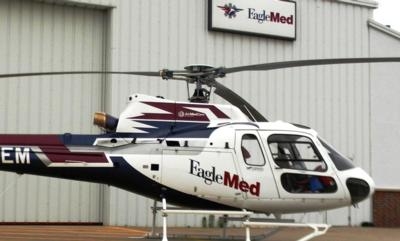Pilot Fatally Injured, Two Others Survived
The NTSB has released its preliminary report from the March 12 accident involving a Eurocopter AS 350 B2 helicopter, N919EM, operating as "Eagle Med 35".

The aircraft was destroyed after it impacted trees and then terrain during maneuvering flight near Eufaula, OK at about 2315 central daylight time. The pilot was fatally injured and the two medical crewmembers sustained serious injuries. The helicopter was registered to and operated by Eagle Med, LLC; Wichita, Kansas. Dark night visual meteorological conditions (VMC) prevailed at the time of the accident and a company visual flight rules flight plan had been filed for the 14 Code of Federal Regulations Part 135 helicopter emergency medical service positioning flight. The helicopter departed from St. Francis Hospital Heliport (4OK3); Tulsa, Oklahoma, about 2248, and was destined for McAlester Regional Airport (MLC), McAlester, Oklahoma.
During the previous northbound flight to transport a patient to the 4OK3 heliport, the pilot mentioned to the medical crew that he noticed that the clouds above their cruise altitude were lower than he expected. The pilot descended slightly and the helicopter landed at 4OK3 without incident. While on the ground the pilot checked weather again and after conferring with the medical crew they decided to begin the planned return flight from 4OK3 to MLC. The helicopter was southbound at a cruise altitude of about 1,500 feet msl when the medical crew reported the helicopter had twice briefly entered and exited instrument meteorological conditions. After a short discussion the pilot then stated he was going to divert, and he began a left turn to return to Tulsa, Oklahoma. Soon after beginning the left turn the helicopter impacted trees and terrain at a surface elevation of about 850 feet msl. The impact resulted in the separation of the tail boom and portions of the fuselage and the main wreckage came to
rest on its right side. The helicopter's fuel tank remained intact, there was no fuel leak, and there was no postimpact fire.
After impact the surviving medical crewmembers extracted themselves from the wreckage and immediately made a cell phone call to report their situation and location. Several agencies then used the position report from the crew, data from the on-board GPS position reporting system, and signals from the 406 MHz emergency locator transmitter to locate the wreckage. Emergency responders hiked in the dark night conditions through the remote rugged terrain and arrived several hours later.
A meteorological reporting station was located at Okmulgee Regional Airport (KOKM) in Okmulgee, Oklahoma, about 20 miles north-northwest of the accident location at an elevation of approximately 720 feet. An automated weather report from OKM at 2315 indicated wind from 020 degrees at 3 knots, visibility of 10 statute miles or greater, ceiling broken at 2,400 feet above ground level (agl), broken cloud layer base at 3,000 feet agl, temperature of 12 degrees C and a dew point temperature of 11 degrees C, and an altimeter setting of 30.13 inches of Mercury. Prior to this report, the lowest cloud layer had been reported as being at or above 5,000 feet agl since 2015, except for 2255, when the lowest cloud layer was reported as being scattered at 1,100 feet agl.
A meteorological reporting station was located at McAlester Regional Airport (MLC) in McAlester, Oklahoma,about 28 miles south of the accident location at an elevation of 770 feet. Beginning at 2153 and continuing through the accident time, MLC automated reporting indicated the lowest cloud bases were between 900 and 2,100 feet agl. A previous report at MLC at 2053 showed overcast clouds with bases at 9,000 feet agl.
(Image from file. Not accident aircraft)
 ANN's Daily Aero-Term (05.05.24): Omnidirectional Approach Lighting System
ANN's Daily Aero-Term (05.05.24): Omnidirectional Approach Lighting System Aero-News: Quote of the Day (05.05.24)
Aero-News: Quote of the Day (05.05.24) Airborne 05.06.24: Gone West-Dick Rutan, ICON BK Update, SpaceX EVA Suit
Airborne 05.06.24: Gone West-Dick Rutan, ICON BK Update, SpaceX EVA Suit Airborne 05.03.24: Advanced Powerplant Solutions, PRA Runway Woes, Drone Racing
Airborne 05.03.24: Advanced Powerplant Solutions, PRA Runway Woes, Drone Racing Aero-News: Quote of the Day (05.06xx.24)
Aero-News: Quote of the Day (05.06xx.24)



